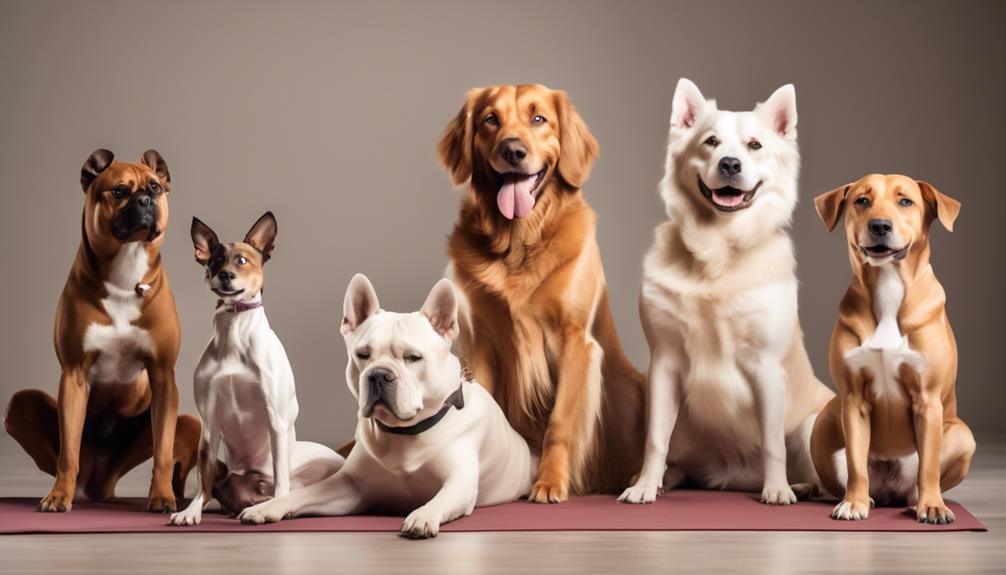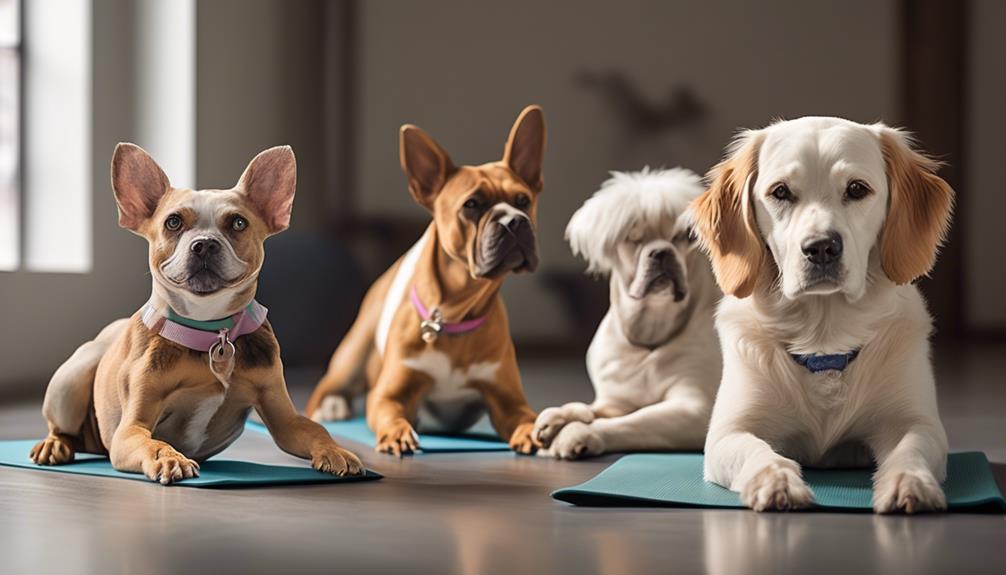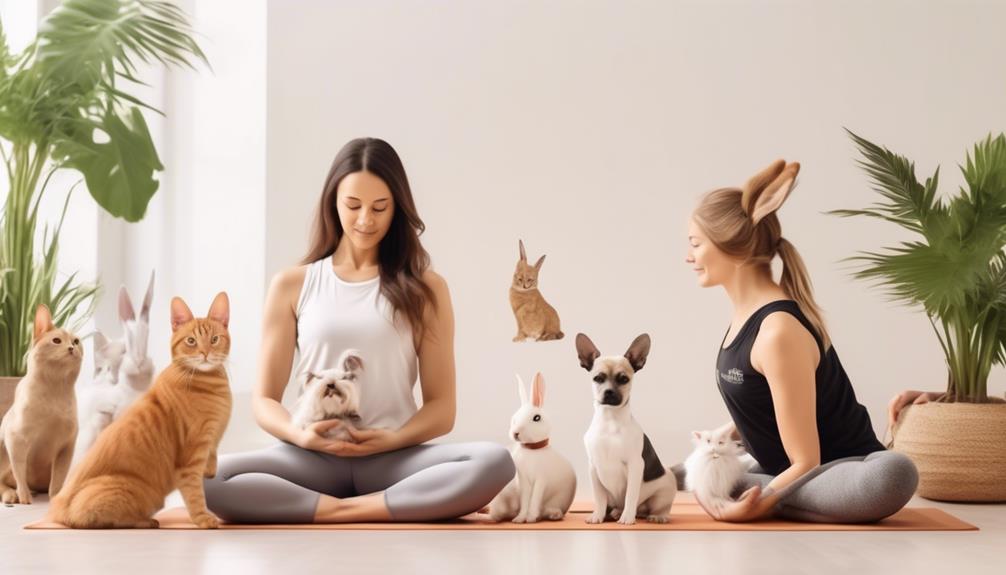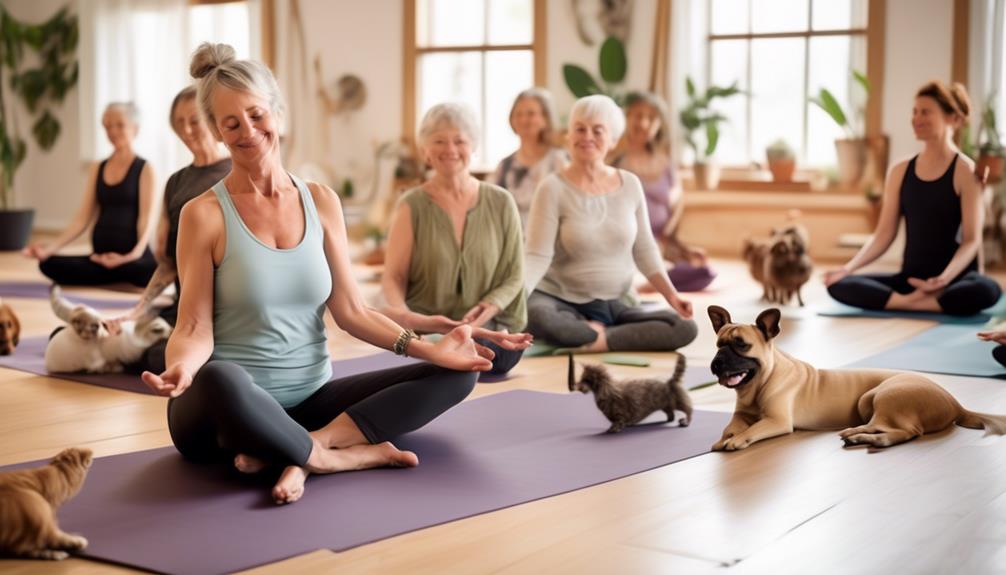Is Pet Yoga Safe for All Breeds and Ages?

Pet yoga can be safe for all breeds and ages. However, it is important to consider individual capabilities and make necessary modifications to ensure a safe practice.
Key Takeaways
- Different breeds have different physical characteristics and abilities, so modifications should be made to accommodate their needs during pet yoga.
- Puppies and kittens have developing bones and joints, so age-appropriate precautions are necessary for young animals during pet yoga.
- Pet yoga promotes overall health and well-being, including weight management, cardiovascular health, and reducing stress and anxiety for both humans and pets.
- Pet yoga strengthens the bond between human and animal, enhancing the connection, trust, and mindfulness between pets and their owners.
Importance of Breed and Age Considerations
Breed and age considerations play a crucial role in ensuring the safety of pet yoga practitioners.
When practicing pet yoga, it's important to understand that different breeds have different physical characteristics and abilities. Some breeds may require specific modifications to ensure their safety and comfort during yoga sessions. For example, brachycephalic breeds, like pugs or bulldogs, have difficulty breathing and may struggle with certain poses that require deep inhalation. In such cases, modifications can be made to accommodate their needs.
Age is another important factor to consider when practicing pet yoga. Puppies and kittens have developing bones and joints, which makes them more susceptible to injuries. It's therefore essential to take age appropriate precautions while practicing yoga with young animals. This may include avoiding certain poses that put excessive strain on their growing bodies or providing extra support to prevent any accidental falls.
Physical Benefits of Pet Yoga

Pet yoga offers a range of physical benefits for both pets and their owners. Engaging in pet yoga can improve flexibility by incorporating various poses and stretches.
Additionally, practicing yoga with pets can strengthen the bond between human and animal, creating a deeper sense of connection and trust.
Health Benefits of Pet Yoga
Engaging in pet yoga offers a multitude of physical benefits for both humans and their furry companions. Not only does it promote overall health and well-being, but it also strengthens the bond between pets and their owners.
Pet yoga, also known as doga, involves incorporating your pet into your yoga practice, allowing for a deeper connection and shared experience. The physical benefits of pet yoga include improved flexibility, balance, and strength for both parties involved. It can also help with weight management and cardiovascular health.
Additionally, pet yoga has been shown to reduce stress and anxiety, promoting mental well-being for both humans and their pets. The combination of physical activity and the calming effects of being with your pet can create a sense of relaxation and inner peace.
Improving Flexibility Through Pet Yoga
By incorporating your furry companion into your yoga practice, pet yoga offers a unique opportunity to enhance flexibility for both you and your pet. Pet yoga poses focus on stretching and lengthening muscles, which can lead to improved flexibility over time. Not only does pet yoga help increase your own flexibility, but it can also have similar effects on your pet. Regular practice of pet yoga can improve balance and increase agility for both you and your furry friend.
Here is a table showcasing three pet yoga poses that can help improve flexibility, balance, and agility:
| Pose | Benefits | How to Perform |
|---|---|---|
| Downward Dog | Stretches the hamstrings and calves | Start on all fours, push your hips up and back, and relax |
| Cat-Cow | Increases flexibility in the spine | Begin on all fours, inhale and arch your back, exhale and round your spine |
| Warrior II | Strengthens the legs and opens the hips | Step your feet wide apart, turn one foot out, bend your front knee, and stretch your arms out |
Incorporating these poses into your pet yoga practice can help improve flexibility, balance, and agility for both you and your furry companion.
Strengthening Bond With Pets Through Yoga
How does pet yoga strengthen the bond between you and your furry companion while providing physical benefits?
Pet yoga not only improves flexibility but also strengthens mindfulness and promotes a deeper connection with your pet. By engaging in yoga poses together, you and your pet can experience a sense of shared relaxation and tranquility.
This shared experience can strengthen the bond between you both, as you focus on your breath and move through the poses in sync. The calming nature of pet yoga can also help reduce anxiety, not only for you but also for your pet.
The gentle movements and soothing environment create a peaceful atmosphere, allowing you both to release tension and find inner peace. Through pet yoga, you and your furry companion can strengthen your relationship while enhancing your physical and mental well-being.
Potential Risks and Precautions

Pet yoga can be a beneficial practice, but it's important to be aware of potential risks and take necessary precautions. While there are many rewards to practicing pet yoga, such as strengthening the bond between pet and owner and promoting relaxation and mindfulness, there are also potential dangers that should be considered.
One potential risk of pet yoga is the possibility of injury to either the pet or the owner. Pets may not be accustomed to the movements and positions involved in yoga, and they may strain or overextend their muscles or joints. Owners, on the other hand, may accidentally apply too much pressure or force on their pets, causing discomfort or injury. It's important to start slowly and gradually introduce pets to yoga poses, ensuring that they're comfortable and not experiencing any pain or distress.
Another risk to consider is the potential for pets to become overwhelmed or stressed during a yoga session. Some pets may not enjoy being touched or manipulated in certain ways, and forcing them to participate in pet yoga can lead to anxiety or aggression. It's crucial to observe and respect the boundaries and comfort levels of pets, making sure to stop the practice if they show signs of stress or discomfort.
To mitigate these risks, it's recommended to consult with a veterinarian before starting pet yoga, especially if the pet has any pre-existing conditions or injuries. Additionally, pet owners should undergo proper training and education on how to safely and effectively perform pet yoga. This includes learning about proper alignment, modifications for different breeds and ages, and understanding the signs of discomfort or stress in their pets.
Modifications for Different Breeds and Ages

When practicing pet yoga, it's important to consider the specific needs of different breeds and ages. Certain poses or movements may be more challenging or even harmful for certain breeds, such as those with short snouts or joint issues.
Likewise, modifications should be made to accommodate the varying levels of flexibility and strength in pets of different ages, ensuring their safety and comfort throughout the practice.
Breed-Specific Considerations
Certain breeds and ages of pets may require modifications during pet yoga to ensure their safety and comfort.
Breed-specific limitations can affect the ability of certain breeds to perform certain poses. For example, brachycephalic breeds, such as Bulldogs and Pugs, may have difficulty with poses that require them to lower their heads or extend their necks. On the other hand, small and toy breeds may struggle with poses that require a lot of strength or flexibility.
Adapting poses for different breeds can involve using props, such as blocks or blankets, to provide support and stability.
It's also important to consider the age of the pet when modifying poses. Puppies and senior dogs may have different limitations and needs compared to adult dogs.
Age-Appropriate Modifications
To ensure the safety and comfort of pets during pet yoga, it's important to consider age-appropriate modifications, taking into account differences in breeds and ages.
Just like humans, pets' bodies change as they age, and certain poses may become more challenging or even risky for them. For older pets, it's crucial to focus on gentle stretching and joint mobility exercises, while avoiding any poses that put excessive strain on their joints or muscles.
Adapting poses for younger pets involves incorporating more playful and dynamic movements to keep them engaged and prevent boredom. Additionally, puppies and kittens have developing bones and joints, so it's essential to avoid any poses that could potentially cause injury.
Safety Tips for a Successful Pet Yoga Session

For a successful pet yoga session, it's crucial to prioritize safety and ensure a harmonious experience for both you and your furry companion. To help you achieve this, here are some safety tips to keep in mind:
- Common injuries: Be aware of the common injuries that can occur during pet yoga, such as strains, sprains, or overexertion. Take precautions to prevent these injuries by starting with gentle stretches and gradually increasing the intensity of the poses.
- Preparing the environment: Set up a safe and comfortable space for your pet yoga session. Remove any objects or obstacles that could pose a risk to you or your pet. Ensure the area is clean and free of any sharp objects. Consider using a nonslip mat to provide stability for both you and your pet.
- Warm-up and cool-down: Just like humans, pets also need to warm up and cool down before and after a yoga session. Begin with some light exercises and stretches to prepare your pet's muscles for the workout. End the session with gentle stretches and relaxation exercises to help your pet cool down.
- Know your pet's limits: Every pet is unique, and not all poses may be suitable for your furry friend. Pay attention to their body language and signs of discomfort. If your pet seems stressed or is struggling with a pose, modify or skip it altogether. Always prioritize your pet's well-being and comfort.
Bonding and Emotional Benefits of Pet Yoga

Pet yoga offers a unique opportunity for pet owners to deepen their bond with their furry companions while experiencing the emotional benefits of practicing yoga together. The practice of pet yoga, also known as doga or cat yoga, has been gaining popularity in recent years due to its ability to promote mental well-being for both humans and animals.
The emotional benefits of pet yoga are numerous. It can help reduce stress and anxiety, improve mood, and enhance the overall sense of well-being. The calming presence of a pet during yoga sessions can create a soothing and peaceful environment, allowing practitioners to fully relax and let go of any tension or worries. Additionally, pet yoga provides an opportunity for pet owners to connect with their pets in a meaningful way, strengthening the bond between them.
When introducing pets to yoga practice, it's important to follow a few tips to ensure a successful experience. First, start slowly and gradually introduce your pet to the practice. Allow them to explore the yoga mat and become familiar with the environment before attempting any poses.
Second, use positive reinforcement and rewards to encourage your pet's participation and cooperation. Finally, always prioritize your pet's safety and comfort, making sure to choose poses and movements that are suitable for their breed and age.
Conclusion: Is Pet Yoga Right for You and Your Pet?

Considering the benefits and safety precautions, pet yoga can be a rewarding and enjoyable practice for both you and your furry companion. Before deciding whether pet yoga is right for you and your pet, it's important to weigh the pros and cons and find the best time for your practice.
Pros of pet yoga:
- Bonding: Pet yoga provides an opportunity for you and your pet to strengthen your bond and deepen your connection through shared relaxation and physical activity.
- Stress reduction: Engaging in pet yoga can help reduce stress and anxiety for both you and your pet, promoting a sense of calm and well-being.
- Physical exercise: Pet yoga incorporates gentle movements and stretches that can improve flexibility, balance, and overall physical fitness for both you and your pet.
- Mental stimulation: Pet yoga can provide mental stimulation for your pet, engaging their mind and keeping them mentally sharp and alert.
Cons of pet yoga:
- Safety concerns: It's important to be mindful of your pet's physical limitations and any underlying health conditions that may make certain poses or movements unsafe.
- Distractions: Some pets may find it challenging to stay focused during a yoga session, particularly if there are other animals or distractions in the environment.
- Allergies: If you or your pet have allergies, it's essential to consider any potential triggers that could be present during a pet yoga session.
- Time commitment: Pet yoga requires time and dedication to practice regularly, so it's important to ensure that you can commit to the necessary time and effort.
Finding the best time for pet yoga:
Consider your pet's energy levels and schedule your yoga sessions during a time when they're calm and relaxed. Avoid practicing yoga immediately after meals or when your pet is overly excited or tired.
Frequently Asked Questions
Can I Do Pet Yoga With Any Breed and Age of Pet?
Pet yoga can be adapted for different breeds and ages, providing numerous benefits. However, it is important to consider any limitations or health conditions that may affect the safety of senior pets participating in yoga activities.
Are There Any Physical Limitations That May Prevent a Pet From Participating in Pet Yoga?
When it comes to pet yoga, there are some physical limitations to consider. While it is generally safe for most breeds and ages, certain conditions or injuries may prevent a pet from participating. Safety precautions should always be taken.
What Are the Potential Risks of Pet Yoga for Older Pets?
Potential benefits of pet yoga include improved flexibility and relaxation. However, older pets may be at a higher risk for common injuries such as muscle strains or joint problems. It is important to consult with a veterinarian before starting pet yoga.
Can Pet Yoga Be Modified for Pets With Specific Health Conditions?
Pet yoga can indeed be modified for pets with specific health conditions. Modifying poses can help accommodate their needs and ensure they can still enjoy the health benefits of pet yoga.
Are There Any Specific Safety Tips to Keep in Mind During a Pet Yoga Session?
During a pet yoga session, it is important to prioritize a proper warm-up for the pet. This helps prevent injuries and prepares the body for the exercises. Taking precautions and being mindful of the pet's limitations is essential for a safe and enjoyable experience.









